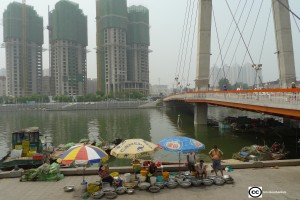Last week’s post looked at the ongoing drought in the Southwestern United States. Residential sprawl there has led to tremendous water waste and the depletion of the Colorado River basin through damming and irrigation. Now we turn to more extreme feats of civil engineering in northern China.
Part II: Northern China

The Hai River in Tianjin. The river basin also houses Beijing. The two cities have a combined population of over 30 million.
The North and Northeast Plains of China are experiencing their worst drought in 60 years, which has already cost farmers $1.2 billion in losses. The North China Plain is one of the densest and most populous regions in the world, home to Beijing and Tianjin, China’s second and fourth largest cities, as well as more than twenty cities with over a million inhabitants. A population this size requires an enormous water supply for domestic, industrial and agricultural uses. China possesses one of the largest amounts of internal renewable water resources in the world but these are not distributed evenly within the country. Northern China contains only about one-fifth of the country’s surface water and in some parts, per capita renewable water resources are as low as 500 m3, less than one-tenth of the global average. Despite this shortage, domestic water waste in cities is a major problem—in part due to the same sprawl factors affecting the Southwestern U.S.— but given that 70% of the region’s water usage comes from agriculture, urban wastefulness is clearly not the main culprit.
To meet the demands of a growing population, it is estimated that China must increase total agricultural production 30% by 2030, requiring an even greater water supply.The dry northern plains contain 65% of the country’s cultivated land and produce half of its grain. As in the U.S. Southwest, the chronic imbalance of productive demands and water supply has led to massive irrigation projects and groundwater mining. In some parts of Northern China, around two-thirds of water withdrawal comes from aquifers. Extraction from the Hai River Basin, which houses both Beijing and Tianjin, has caused its aquifers to decline at a rate of up to 8.8 km3 per year. To address the chronic problem of water scarcity, the Chinese government has begun construction on the North-South Water Diversion Project. It entails around 2,400 kilometers of canals to bring water from the water-rich south of the country to the drier north, the largest such project in world history. In addition to the construction costs—one estimate put it at $62 billion—and the displacement of up to half a million people living near construction zones, there are concerns about this megaproject’s effect on southern China’s aquifers and watersheds. Notably, the Chinese government has indicated their intention to use the North-South diversion project to stimulate coal-fired electrical plants in the North, which would actually compete with farmers for water.
Furthermore, the whole project temporarily averts the larger problem of unsustainable water use by agriculture and industry. And as population, economy and industry continue to grow in Northern China, this postponement may not last long. One part of the problem is inefficiency. Chinese irrigation systems and industrial processes are relatively inefficient when compared to other countries, leading to low agricultural productivity of $3.6 per cubic meter of water and tremendous waste. The Economist has criticized China’s heavy subsidies of water as the main cause of this inefficiency, arguing that there is no incentive to consume wisely. This may be true but raising prices to market levels could also lead to unequal water access, allowing wealthier families and farms to waste water while poorer ones go without. Perhaps the bigger problem lies in the water supply. China’s major rivers are so polluted that 80% of them do not support fish and only 3% of cities have clean groundwater. The pollution of surface water caused by pesticides, fertilizers, industrial waste and improperly-treated wastewater leads to unsustainable groundwater extraction.
As water resources dwindle in the North, the Chinese government is gambling on a costly water diversion project that will harm southern ecosystems and communities rather than addressing one of the root causes of scarcity. Pollution on this scale drastically limits the usable water supply. Civil engineering and liberalizing the water market will not change this fundamental fact.
Next week: One of Colombia’s largest coal mines uses 17 million liters of water each day while the region’s inhabitants try to survive on less than one.








Comentarios recientes